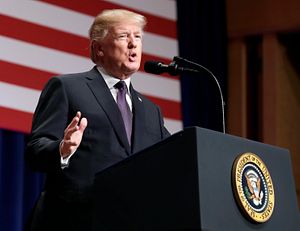The new National Security Strategy (NSS), which the White House rolled-out on December 18, 2017, is long on self-described realism but short on geoeconomic strategy. Proclaiming a return to principled realism, the NSS defines the international system as one of great power competition in which China and Russia are revisionist powers challenging the status quo and strategic competitors to the United States. The NSS also lays the charge that for several decades U.S. foreign policy has been shaped by the misguided belief that “engagement with rivals and their inclusion in international institutions and global commerce would turn them into benign actors and trustworthy partners.”
This realist conceptual framework is a welcomed and long overdue departure from previous and successive administrations. However, the NSS triumphantly kills some darlings of liberal internationalist foreign policy only to replace them with a few of its own making — economic nationalism with a singular if not myopic obsession with trade reciprocity and bilateral trade agreements. To be sure, the White House is correct to take a tougher approach toward China on unfair trade practices, particularly involving intellectual property rights and technology transfer, as well as enhanced scrutiny of Chinese investment in the United States. Also, greater trade reciprocity would strengthen the U.S. balance sheet vis-a-vis China on a bilateral basis.
Such bilateral and retaliatory measures offer little in terms of challenging or offsetting China’s geoeconomic ground game in Asia. With only three years left in office, some of which will be focused on renegotiating NAFTA and KORUS, the administration will be hard pressed to negotiate enough bilateral FTAs in Asia to compensate for having withdrawn from the Trans-Pacific Partnership (TPP). At a minimum, the White House would need to initiate and successfully conclude FTAs with Japan and Vietnam as well as resuscitate talks with the Philippines, Thailand, Malaysia and Indonesia. This is a moon shot considering that the zero-sum priority on lowering trade deficits is likely to complicate or derail FTA negotiations — if not overall relations — with regional allies and emerging security partners.
Conspicuously, the NSS makes no mention of China’s Belt and Road Initiative — the most ambitious and potentially transformational geostrategic project in the world — or the Asian Infrastructure Investment Bank, which together offer a parallel Sino-centric order or sphere of influence. Neither does the NSS recognize efforts by Japan and the remaining TPP members to move forward without U.S. participation or even acknowledge other regional multilateral trade initiatives such as the Regional Comprehensive Economic Partnership (RCEP) which would exclude the United States. In short, the White House trade agenda risks setting up the U.S. to be caught on the outside of the trend in regional trade architecture to the benefit of China.
The strategic question for the White House is not simply whether its preferred trade and economic policies improve the U.S. balance sheet, but whether those policies will enable the U.S. and its allies to continue to write rules of global trade and finance and to compete with China at a geoeconomic level. In this context, the NSS for all its hard-nosed and clear-eyed realism fails to lay out a coherent and comprehensive geoeconomic road map that guides U.S. policy toward Asia while reassuring U.S allies and partners in the region.
However, there is one bright spot that gets disjointed treatment within the document — promoting U.S. oil and LNG exports as well as high-quality infrastructure abroad. The White House should have highlighted the synergy derived from linking the two initiatives together and identified these areas as priority action items for the Indo-Pacific. The recently launched Japan–United States Strategic Energy Partnership that was accompanied by agreements by the U.S. Trade and Development Agency, U.S. Overseas Private Investment Corporation, and Japan’s Ministry of Economy, Trade and Industry (METI), to promote high-quality infrastructure in the Indo-Pacific, is a starting point for a much broader regional geo-economic strategy.
In comparison, it is worth noting that in 2016 Japan pledged $200 billion over just five years to help finance its Expanded Partnership for Quality Infrastructure, launched the Asia-Africa Growth Corridor with India in May 2017, and more recently announced a public-private initiative to provide $10 billion in financial support to build LNG and natural gas infrastructure in Asia.
Going forward, the White House would be well advised to set aside its singular obsession with zero-sum trade reciprocity and the presumptive silver bullet of bilateralism to fully commit to a coherent and comprehensive geoeconomic strategy with generously allocated resources if it wants to preserve the U.S. led rules-based order in Asia and counter China’s grand strategy to carve out a parallel Sino-centric order or sphere of influence. In other words, the United States needs to put money on the table now — even if it not reciprocated — or run the risk of “losing” Asia in the long run.
Jeremy Maxie is an Associate at Strategika Group Asia Pacific. He tweets at @jeremy_maxie.
































